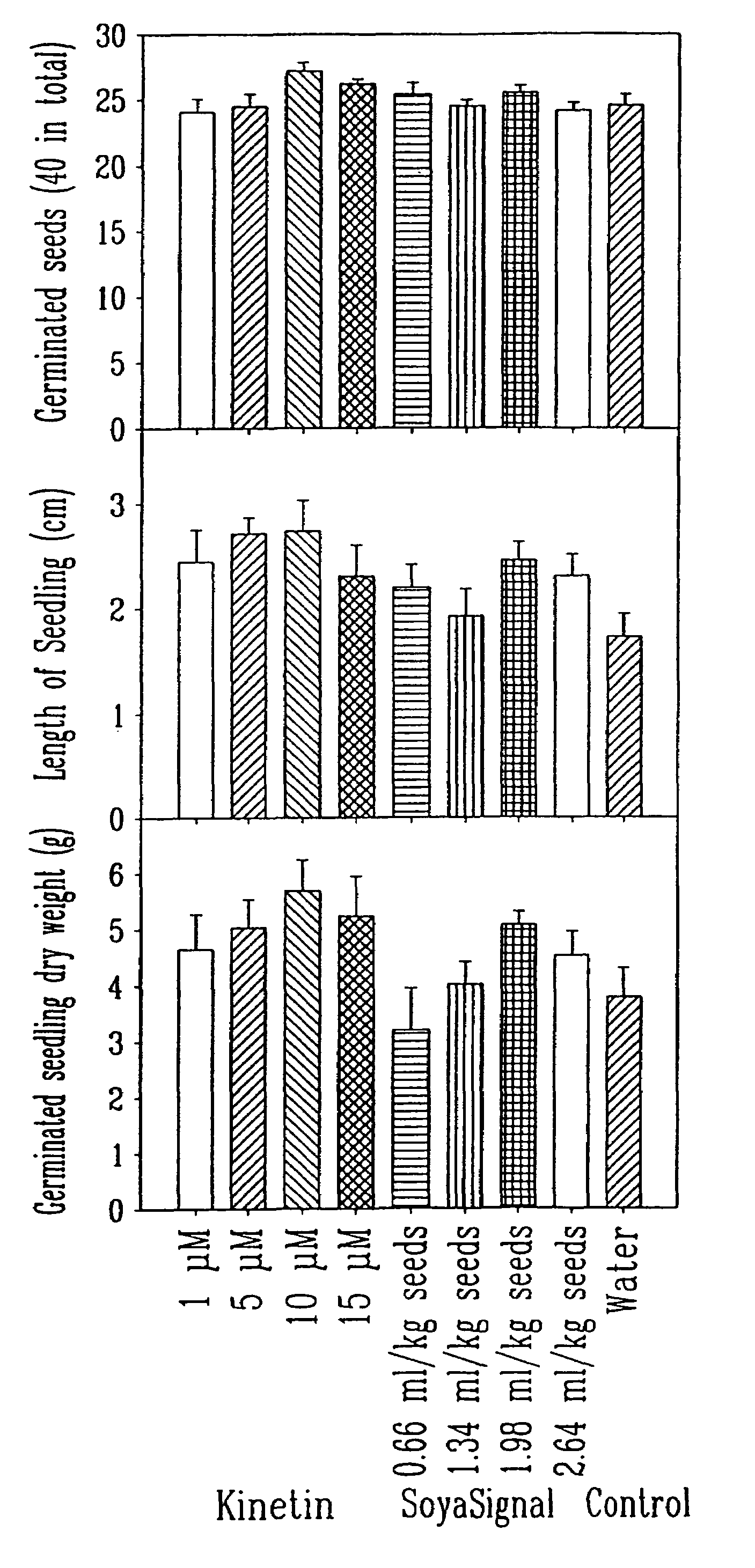Composition for accelerating seed germination and plant growth
a technology of seed germination and plant growth, applied in the field of agriculture, can solve the problems of non-legumes' role in such bacteria-to-plant signal molecules, and the effect of lcos on processes other than nodulation of legumes has not yet been studied, so as to enhance the growth of plants
- Summary
- Abstract
- Description
- Claims
- Application Information
AI Technical Summary
Benefits of technology
Problems solved by technology
Method used
Image
Examples
example 1
Induction of LCO Production by Bradyrhizobium japonicum
[0059]The first culture containing Bradyrhizobium japonicum (strain 532C) was grown at 28° C. in 100–125 mL of sterile yeast mannitol media (YEM) with pH 6.8, shaken at 150 rpm until the OD620 reaches 0.4–0.6 (4–6 days). Thereafter, a 2L bacterial subculture was started by inoculating with material from the first culture (5 mL of first culture per 250 mL of YEM media), for 5–7 days (OD620˜0.8–1.0), as above. At this stage, 0.25 L of 50 μM genistein (in methanol) were added to each 250 mL of bacterial subculture (genistein concentration of 5 μM) and the culture was incubated for 48–96 hours, the flavone thereby inducing LCO production in the bacterial cells.
example 2
Induction of LCO production by Rhizobium meliloti or Rhizobium leguminosarum
[0060]The first culture of Rhizobium meliloti strain RCR2011 was grown at 28° C. in 100–125 mL of sterile yeast mannitol media (YEM) with pH 6.8, shaken at 150 rpm until the OD620 reaches 0.4–0.6 (2–3 days). Thereafter, a 2L bacterial subculture was started by inoculating first culture (5 mL of first culture per 250 mL of YEM media), for 2–3 days (OD620˜0.8–1.0), as above. At this stage, 0.25 mL of 50 μM luteolin (in methanol) was added to each 250 mL of bacterial subculture (luteolin concentration of 5 μM) and the culture was incubated for 48 hours, the flavone thereby inducing LCO production in the bacterial cells.
[0061]For LCO production by Rhizobium leguminosarum, the rhizobia was grown similarly as above. The flavone (naringenin) was added to the subculture of R. leguminosarum (10 μM) and the procedure carried out as above.
example 3
Extraction and Purification of LCOs
[0062]Two liters of bacterial subculture were phase-partitioned against 0.8 L of HPLC-grade 1-butanol by shaking overnight. The upper butanol layer was then transferred to a 1 L evaporation flask and evaporated at 80° C. to 2–3 mL of light brown, viscose material with a Yamato RE500 Rotary Evaporator, which was resuspended in 4 mL of 18% acetonitrile and kept in the dark at 4° C. in a sealed glass vial.
[0063]HPLC analysis was conducted with a Vydac C18 reversed-phase column with flow rate 1.0 mL / min and a Vydac guard column. As a baseline, acetonitrile (AcN / H2O; w / w) was run through the system for at least 10 min. When the sample was loaded, an isocratic elution was started by 18% of AcN for 45 min. This step aims at removing all non-polar contaminant light fractions. Thereafter, a gradient elution for 90 min. with 18–82% AcN was performed. LCOs began to elute after 94–96 min. of HPLC run time.
[0064]For the purification of LCOs from R. leguminosaru...
PUM
 Login to View More
Login to View More Abstract
Description
Claims
Application Information
 Login to View More
Login to View More - R&D
- Intellectual Property
- Life Sciences
- Materials
- Tech Scout
- Unparalleled Data Quality
- Higher Quality Content
- 60% Fewer Hallucinations
Browse by: Latest US Patents, China's latest patents, Technical Efficacy Thesaurus, Application Domain, Technology Topic, Popular Technical Reports.
© 2025 PatSnap. All rights reserved.Legal|Privacy policy|Modern Slavery Act Transparency Statement|Sitemap|About US| Contact US: help@patsnap.com



